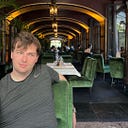Communication Systems
I’m happy to announce that Communication Systems, a multimedia project that I worked on with my cousin, Samuel Hardman, a designer and artist, is available on his website:
Communication Systems is an encompassing work that combines poetry, illuminations, and augmented reality.
The poetry at the core of this project uses form and structure to mimic the processes of an electrical communication system through two cycles of AWGN (Average White Guassian Noise), Handshake, Sampling, Phase Error, Parity, Transmission, and Aliasing poems — each of which demands specific modes of reading. When there are multiple columns on a single page, for instance, those columns are meant to be read simultaneously by different readers, which recreates electrical processes in an auditory event. But while these formal aspects are metaphorical, the subjects of the poems are grounded by personal experiences of engineering school and rural life in southern Indiana.
The illuminations on each page work against this poetic/auditory relationship, instead establishing their own bric-a-brac meanings relating the poems as written to the visual response they provoke. Each illumination is intended to invoke the presence of an unseen artist who left their mark haphazardly across a book they happened to come across.
Finally, the book itself, which is designed to look like an instruction manual or datasheet, is the key to an AR experience that can be accessed through the CommSys iPhone app. You can find the app here:
You can use the image at the top of this Medium post to run the app (print it off or display it via tablet on a flat surface), and you can see a preview of how to run the app here:
When the app is opened, the user looks at the cover of the book through their phone. The “transmit” button turns blue, the user presses it, and a void opens over the cover of the book. A radio tower rises out of the void and four robotic readers made of pulsing, electrical light perform the poems while they swirl around the tower. The locations of the robotic readers are semi-random, allowing for a freedom of movement within a constrained dance specific to each poem. The voices are also randomly generated, and the result is a poetic reading that is unique to each user and each performance.
Our goal in combining these media is to highlight how random information (letters on a page, phonemes of a word, lines of a drawing, or randomly driven robots) is given meaning through mediation, how that meaning is unique to each person and experience, and the parallels between these secular, meaning-constructing processes and religious practices. At the same time, we hope to show that something completely human, which is anchored in how we tell stories about our lives, provides a common ground that unites our unique ways of understanding the world.
More personally, I want to say how much I enjoyed making this with Sam, and how important engineering art is to me.
I used to work on the undergraduate literary magazine at Rose-Hulman Institute of Technology, a small engineering school in Indiana. My brain is not made for engineering, and those years were rough. It was the literary magazine, the great professors in the humanities department, and the 60 credits or so of literature classes I took that got me through it. And it was during those trails of trig and calc and vectors and labs, peppered with some writing, that I really learned to appreciate engineering art. I even wrote a Medium article years ago about the struggles of leaving the creative opportunities of undergrad for a strict working environment:
Reconnecting with the humanities professors at Rose this past homecoming weekend made me feel again how important engineering art is. I don’t know if engineering is as important to the world as I thought it was when I wrote the Editor’s Introduction to Ink my senior year — getting older means recognizing that some things aren’t fixed by engineering a good, or even a profound, experience— but it is important to me. Engineering art gives me a way to use the skills I fought so hard to earn in undergrad for me. I get to be the inventor of something new, and that means so much. For that, I’m still deeply indebted to the humanities department at dear old Rose and the act of engineering art they taught me while I was there.
I also want to thank folks like DiAmaya Dawn and Stephen M. Tomic, as well as places like Lit Up, The Junction, and P.S. I Love You for giving me spaces on Medium to express myself.
